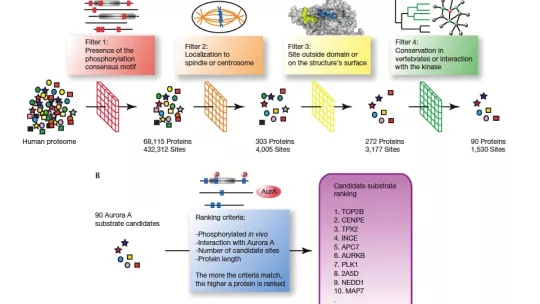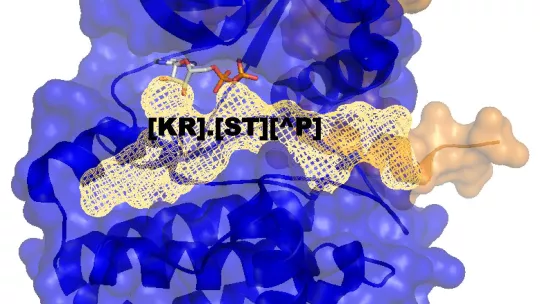Images
Scientists at IRB Barcelona develop a computational strategy to identify potential protein interaction partners regulated by Aurora A kinase.
The oncogene Aurora A kinase is involved in the regulation of key aspects of the cell cycle. However, very little is known about how this protein achieves its many cellular functions and the proteins it regulates, etc. A team headed by ICREA researcher Patrick Aloy at IRB Barcelona has developed, in collaboration with Center for Genomic Regulation, a computational strategy to identify new molecules regulated through phosphorylation by Aurora A. This work has been published in EMBO reports, a prestigious journal that forms part of the Nature Publishing Group.
Aurora A belongs to a group of proteins responsible for regulating the activity of others, thereby controlling the most basic functions of cells. “We only know of 17 proteins that Aurora A modulates and these do not explain all the functions attributed to this protein”, explains Patrick Aloy. Therefore these researchers addressed this issue by designing a computational strategy to find potential targets of this protein. This tool passes molecules through virtual “filters” that select those that have characteristics that would allow them to interact and be phosphorylated by Aurora A. They found 90 possible candidates and of these chose 10 at random to test their predictions in biological systems. Eight of these molecules were found to be indeed regulated by Aurora A in vitro, representing a prediction accuracy of their strategy of 80%.
Knowledge of the distinct functions of Aurora A is of great importance as the protein is vastly over-expressed in several tumor types. Furthermore, in cancer patients, these high expression levels are associated with a poor prognosis. Research efforts have been going on for some years into the search for drugs that block the action of Aurora A. In fact, several therapeutic compounds are currently being tested in clinical trials in humans. The identification of Aurora A substrates presented in this study will contribute to contextualize their functions and to a better understanding of the possible side effects caused by their inhibition.
Reference article:
Uncovering new substrates for Aurora A kinase.
Teresa Sardon, Roland A Pache, Amelie Stein, Henrik Molin, Isabelle Vernos & Patrick Aloy.
EMBO Reports (2010, 11(12): 977-984) [DOI: 10.1038/embor.2010.17]
About IRB Barcelona
The Institute for Research in Biomedicine (IRB Barcelona) pursues a society free of disease. To this end, it conducts multidisciplinary research of excellence to cure cancer and other diseases linked to ageing. It establishes technology transfer agreements with the pharmaceutical industry and major hospitals to bring research results closer to society, and organises a range of science outreach activities to engage the public in an open dialogue. IRB Barcelona is an international centre that hosts 400 researchers and more than 30 nationalities. Recognised as a Severo Ochoa Centre of Excellence since 2011, IRB Barcelona is a CERCA centre and member of the Barcelona Institute of Science and Technology (BIST).






